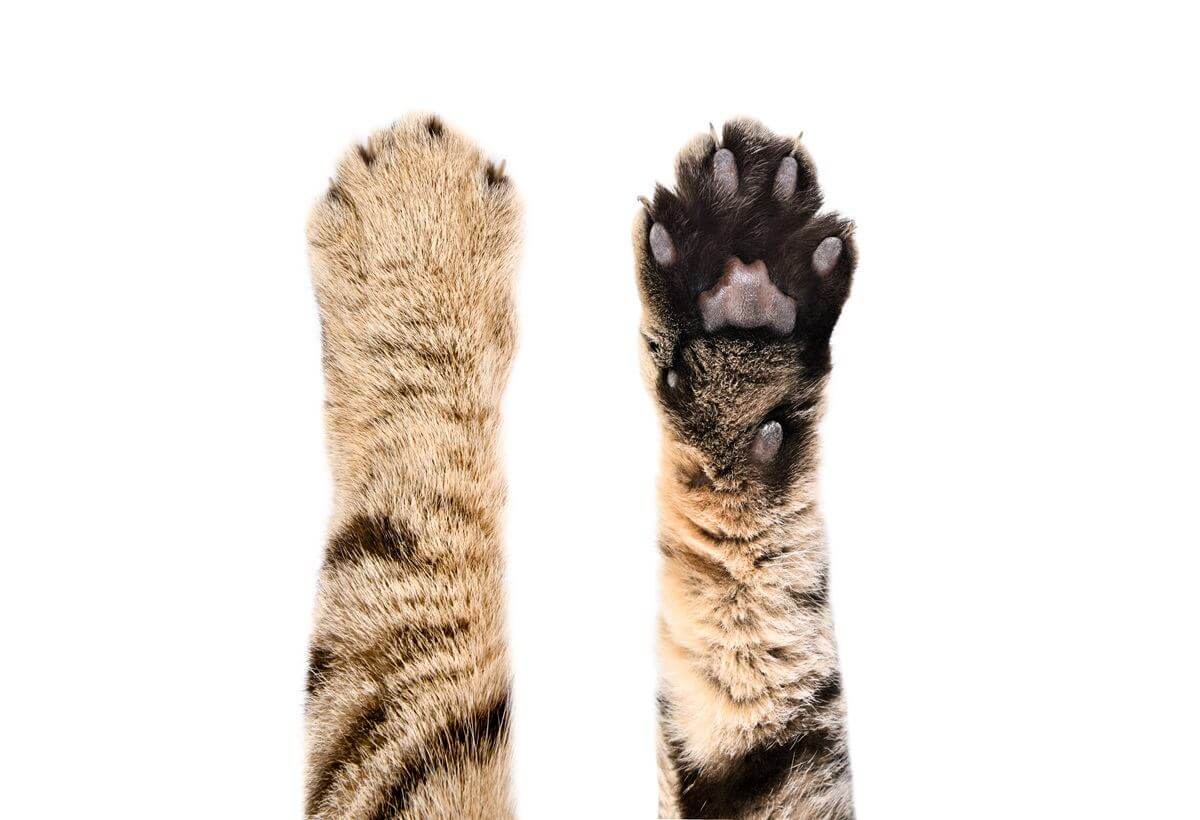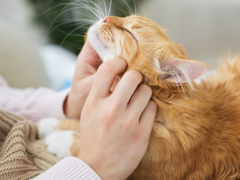
Sonsedska Yuliia / Shutterstock.com
Cutaneous horns are hard horn-like growths you might see growing from your cat’s paw pad – a bit like an extra claw. A surprisingly common skin condition, they feel like hard, thickened bits of skin. This is because cutaneous horns are made from a build-up of keratin, the same protein that makes up hair, nails, and skin. They are usually found on the feet, but they can occur on any part of the body – even the face!
If they aren’t on a weight-bearing part of the paw, these strange-looking lesions aren’t usually painful and don’t cause any harm. But like with any new lumps or bumps, it’s a good idea to get them checked by your veterinarian. In rare cases, they can be associated with more serious conditions such as feline leukemia virus (FeLV), papillomavirus, and certain types of tumors.
Read on to learn exactly what causes cutaneous horns, when to worry about them, and what to do if your cat has them.
What Do Cutaneous Horns Look Like?

This cat has a cutaneous horn growing from their stopper pad. Yvette Rowntree / Shutterstock.com
Cutaneous horns are hard growths that look like little horns or claws. They are brownish-yellow and usually range in hardness from a piece of thickened skin to the same consistency as your cat’s claw.
They usually grow from the sides of the paw pad or near the nail bed, which is why they’re commonly mistaken for an extra claw. Some cats only have one, but they often affect multiple paw pads. Whilst you’ll most likely find them around the feet, they can actually grow from any part of your cat’s body.
What Causes Cutaneous Horns?
Cutaneous horns are caused by an overgrowth of keratin, a type of protein. Your cat’s body needs keratin to produce hair, claws, and the outer layer of their skin. But too much keratin can cause extra growths to form.
Most of the time we don’t know what’s caused the body to produce the extra keratin—the horns just appear spontaneously. But in some cases, it’s thought that cutaneous horns develop because of excess friction or pressure on the paw pads of particularly adventurous cats—just like calluses on the feet of keen hikers. The repeated pressure causes the pad to produce excessive keratin, resulting in the horny growths. These types of cutaneous horns rarely cause problems and may even provide some protection against hard surfaces.
However, occasionally the appearance of a cutaneous horn can be a sign of something more serious. They’re known to occur in cats infected with feline leukemia, a serious virus that affects the immune system. Cats infected with FeLV tend to develop cutaneous horns in the center of the paw pad, as opposed to at the edge. These horns are more likely to cause discomfort, as they can interfere with your cat’s walking.
Also Read: What To Know When Adopting an Felv-Positive Cat
Cats suffering from FeLV usually show other signs of being unwell, such as lethargy or fever. If your veterinarian is concerned about the possibility of FeLV, they can rule it out with a simple blood test. However, in my experience as a veterinarian, most cases of cutaneous horns are harmless and not related to FeLV.
Other rare but important causes of cutaneous horns include papillomavirus infection, actinic keratoses, and some types of tumors, such as squamous cell carcinomas.
How Are Cutaneous Horns Diagnosed?
In most cases, your veterinarian will diagnose a cutaneous horn based on their appearance alone.
However, these growths can look like other skin conditions or cancers. If your vet is unsure or concerned they could be a sign of something more serious, they may recommend a biopsy. This involves removing some or all of the horn and sending it away to be examined under a microscope. This test will distinguish between a harmless cutaneous horn and a different type of skin lesion, including a skin tumor.
Your veterinarian may also check for FeLV infection using a simple blood test.
Are Cutaneous Horns Painful for Cats?

Lifting their paw can be a sign that your cat is in pain. Robert Petrovic / Shutterstock.com
Most cutaneous horns don’t cause any pain or discomfort. The only time they can become a problem is if they form on a weight-bearing part of the body, such as towards the middle of a paw pad. Horns located here can press on the paw pad while your cat is walking, causing discomfort.
So, whilst most cutaneous horns don’t hurt, it’s important to observe your cat for any signs of pain. This could include lameness on the horned paw, changes to activity levels, or licking around the area. It’s a good idea to examine the horn every few weeks to check for redness, swelling, or discharge that may indicate a problem.
If you’re worried your cat might be in pain, you should always get them checked over by your veterinarian.
Do Cutaneous Horns Require Treatment?
As long as your cat’s cutaneous horn isn’t causing them any discomfort, it’s unlikely they will need any treatment. You might worry that you need to cut it if it is growing too long. This can be a good idea, but as a veterinarian, I never recommend cutting cutaneous horns yourself. This is because it can be tricky to tell horn tissue apart from the healthy tissue.
Accidentally cutting healthy tissue risks causing your cat pain, bleeding, and infection. So, book your cat in with a veterinary professional if you think it needs trimming. They can confirm exactly what it is, and whether it needs any treatment.
If your cat’s cutaneous horn is causing them discomfort, or your veterinarian is worried about it, they may recommend removing it. Surgical removal is generally only necessary for horns growing on a weight-bearing area of the paw pad. Your veterinarian will usually remove the base of the horn as well as the outgrowth to prevent it from regrowing. The removed horn can be sent away to a laboratory to make sure it isn’t anything to worry about. Most cats recover well at home after a week or two.
How Can You Help at Home?

If your cat has cutaneous horns, the best thing you can do is monitor them at home. Svetlana Rey / Shutterstock.com
Unless your cat is bothered by their cutaneous horn, you don’t need to do anything except keep an eye on it. In fact, as a veterinarian, I would generally recommend leaving them alone unless they are causing an issue.
Some cat owners try softening the horn with pet-safe moisturizers or emollients. But in my experience, this is rarely effective or necessary. The most important thing you can do at home is monitor the horns for any changes or signs of discomfort and get it checked if you’re worried.
Also Read: 12 Warning Signs Your Cat Is in Pain
Can You Prevent Cutaneous Horns in Cats?
There’s not much you can do to prevent your cat from developing cutaneous horns. Most of the time, cutaneous horns develop spontaneously or simply as a result of friction on the feet. So, you don’t need to worry about trying to prevent them.
The only important thing you can do is to ensure your cat’s vaccinations are up to date. Feline leukemia infection is a known (albeit rare) cause of cutaneous horns in cats. Whilst cutaneous horns rarely cause a problem, FeLV is a life-threatening, incurable condition. The good news is you can protect your cat against FeLV by vaccinating them against it as kittens and keeping them up to date with their annual vaccinations as adults.
Frequently Asked Questions
What causes cutaneous horns in cats?
Cutaneous horns are caused by an overgrowth of keratin, the protein that makes up hair, skin, and nails. In most cases they are harmless, and either occur spontaneously or in areas of pressure on the paw pad (a bit like a callus). Rarely, they can be seen with more serious conditions such as FeLV, or certain tumors.
How do you get rid of a cutaneous horn on a cat?
In most cases, cutaneous horns don't cause your cat any problems. So, it is usually best to leave them alone. However, if they are causing your cat discomfort - or you are worried they might be something more serious - you should speak to your veterinarian about removing them. It's generally best not to try and trim them at home.
Why does my cat have an extra claw?
Some cats - called polydactyl cats - have extra toes on their feet. However, it's also common to mistake a common skin condition called "cutaneous horns" for extra toes. These hard thickened bits of skin often grow from the paw pads, and can look a lot like an extra claw. The good news is whether your cat has extra toes or a cutaneous horn, both conditions are usually harmless.
Can I cut my cat's cutaneous horns?
As a veterinarian, I never recommend that owners cut their cat's cutaneous horns at home. This is because it can be hard to tell the hard skin apart from healthy skin, risking bleeding, pain, and infection. It's always safest to take your cat to the veterinarian so they can examine the horn, confirm the diagnosis, and recommend the best way to treat them - if they need any treatment at all.
Is it normal for cats to have calluses?
Yes! Just like us, cats can get calluses on their feet when they do lots of walking. The pressure and friction on the paw pads can cause an overgrowth of keratin, resulting in areas of hard skin called "cutaneous horns". These are usually harmless, but it's always worth getting any new lesion checked by a veterinarian.







